Equality, Diversity & Inclusion (EDI) information held by the HCPC with regards to the nine protected characteristics of the Equality Act 2010
This factsheet provides key EDI information for practitioner psychologists and how the demographics of this group compare to the demographics of HCPC registrants overall.
In the download section below, you will also find a breakdown of the different practitioner psychologist modalities.
Demography:
For age and sex: all current registrants.
For other protected characteristics: all current registrants who have submitted EDI data via the EDI portal or survey:
- 100% of practitioner psychologists
- 66% of all professions combined
Period:
As at 4 July 2023.
Diversity data factsheet: practitioner psychologists
-
Question asked:
"What was your date of birth"
Note:
This was used to calculate current age at the point of production of this factsheet.Practitioner Psychologists
All professions
Age Count % Count % Not recorded 0 0% 35 0% Recorded 27,085 100% 324,640 100% 20-29 450 2% 52,410 16% 30-39 7,945 29% 99,185 31% 40-49 9,375 35% 84,395 26% 50-59 5,905 22% 61,460 19% 60-69 2,530 9% 24,135 7% 70+ 880 3% 3,055 1% 27,085 100% 324,640 100% 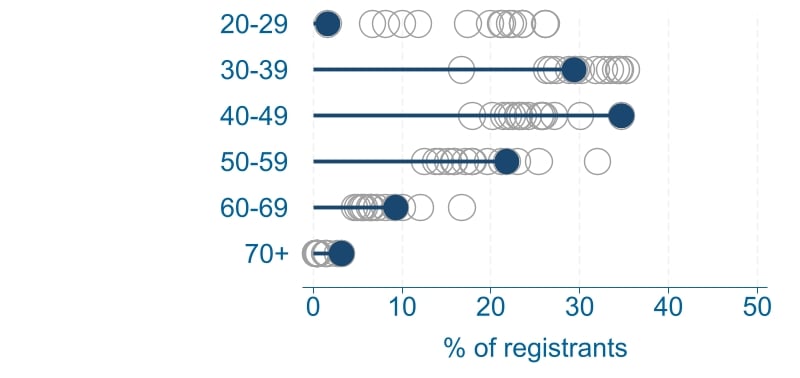
-
Question asked:
"Do you consider yourself to have a disability or to be a disabled person?"
Accompanying note in portal:
In the UK, a disability is defined as "a physical or mental impairment which has a substantial and long-term* adverse effect on a person's ability to carry out normal day-to-day activities" You may have none, one, or more conditions that you believe are covered by this definition. Please answer how you feel this definiton applies to you. (*long-term means that the impact has lasted, or is expected to last, for 12 months or more)
Note:
HCPC does collect further data on long term conditions, however the protected characteristic is disabilty status rather than disabling condition.Practitioner Psychologists
All professions
Disability Count % Count % Not recorded 0 0% 20 0% Recorded 26,935 100% 214,490 100% No 24,135 90% 196,115 91% Yes 1,590 6% 11,310 5% Prefer not to say 1,210 4% 7,065 3% 26,935 100% 214,490 100% 
-
Question asked:
"Which of the following best describes your ethnic origin? Ethnicity is defined as including colour, ethnic or national origin, or nationality. Please choose whichever answer best reflects how you think of yourself."
Portal category options:
- White
- Asian or Asian British
- Black, African, Caribbean or Black British
- Mixed or multiple ethnic groups
- Other ethnic group
- Prefer not to say
Note:
The categories presented here are the high level categories collected by HCPC. Respondents are also asked for a lower level category (18 options) based on their high level response.Practitioner Psychologists
All professions
Ethnicity Count % Count % Not recorded 0 0% 5 0% Recorded 26,940 100% 214,515 100% White 22,605 84% 164,630 77% Asian 1,395 5% 23,740 11% Black 510 2% 10,810 5% Mixed 830 3% 4,475 2% Other 515 2% 2,990 1% Prefer not to say 1,085 4% 7,870 4% 26,940 100% 214,515 100% 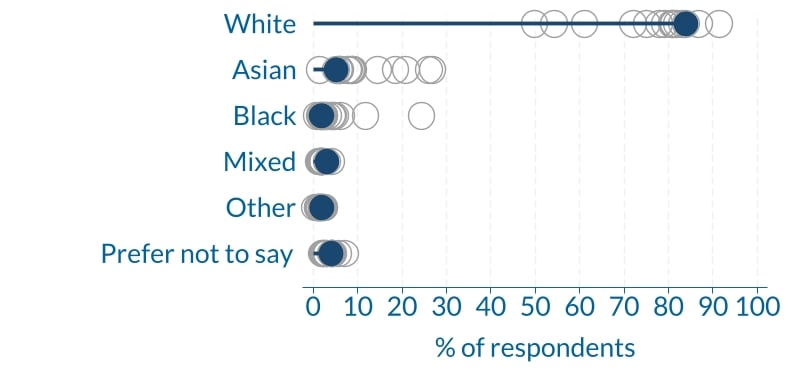
-
Question asked:
"Is the gender you identify with the same as your sex registered at birth?"
Accompanying note in portal:
Your gender identity may be the same as your assigned sex, but it may be different. You may identify as the opposite gender to your assigned sex, you may identify with neither, or with a self-described gender identity.Practitioner Psychologists
All professions
Gender Reassignment Count % Count % Not recorded 10 0% 220 0% Recorded 26,925 100% 214,295 100% Yes 25,690 95% 207,470 97% No 50 0% 490 0% Prefer to self-describe 55 0% 220 0% Prefer not to say 1,130 4% 6,115 3% 26,925 100% 214,295 100% 
-
Question asked:
"What is your legal marital or registered civil partnership status?"
Portal category options:
- Married
- Never married and never registered in a civil partnership
- Divorced
- In a registered civil partnership
- Separated but still legally married
- Widowed
- Formerly in a civil partnership which is now legally dissolved
- Separated but still legally in civil partnership
- Surviving partner from a registered civil partnership
- Prefer not to sayPractitioner Psychologists
All professions
Marriage and Civil Partnership Count % Count % Not recorded 0 0% 25 0% Recorded 26,935 100% 214,495 100% Married (M) 15,420 57% 104,525 49% Never married or CP 6,335 24% 75,415 35% Separated & div. (M) 1,655 6% 11,720 5% In Civil Partnership (CP) 270 1% 1,795 1% Separated, not div. (M) 390 1% 2,725 1% Widowed (M) 225 1% 1,375 1% Separated & dis. (CP) 25 0% 135 0% Separated not dis. (CP) 10 0% 80 0% Widowed (CP) 5 0% 35 0% Prefer not to say 2,600 10% 16,690 8% 26,935 100% 214,495 100% 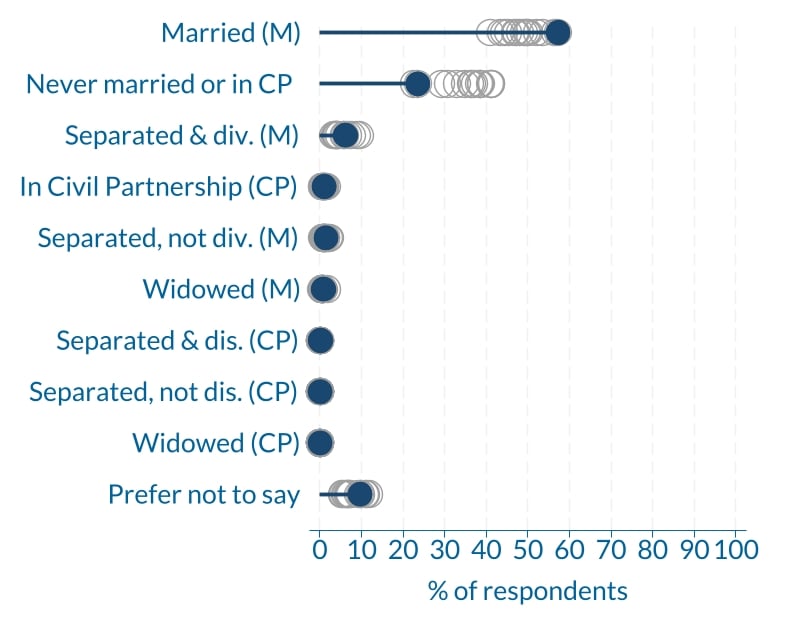
-
Question asked:
"Do you consider your self to fall under the protected characteristic of 'pregnacy & maternity', as per the Equality Act 2010? 'Pregnancy' refers to the condition of being pregnant or expecting a baby, and 'maternity' refers to the period of 26 weeks after birth. The Equality Act 2010 protections also cover a someone who has had a miscarriage."Practitioner Psychologists
All professions
Pregnancy and Maternity Count % Count % Not recorded 5 0% 100 0% Recorded 26,935 100% 214,410 100% No 23,810 88% 191,445 89% Yes 1,480 5% 10,720 5% Prefer not to say 1,645 6% 12,245 6% 26,935 100% 214,410 100% 
-
Question asked:
"What is your religion or strongly held belief, if any?"
Portal category options:
- No religion or strongly held belief
- Christian (Including Church of England, Catholic, Protestant and all other Christian denominations.)
- Muslim
- Hindu
- Spiritual
- Buddhist
- Any other religion or belief
- Jewish
- Sikh
- Prefer not to sayPractitioner Psychologists
All professions
Religion or Belief Count % Count % Not recorded 0 0% 15 0% Recorded 26,940 100% 214,500 100% No religion 14,135 52% 89,340 42% Christian 7,105 26% 83,300 39% Muslim 425 2% 8,770 4% Hindu 275 1% 6,085 3% Spiritual 940 3% 4,435 2% Buddhist 305 1% 1,610 1% Other 240 1% 1,880 1% Jewish 500 2% 1,420 1% Sikh 175 1% 1,000 0% Prefer not to say 2,840 11% 16,660 8% 26,940 100% 214,500 100% 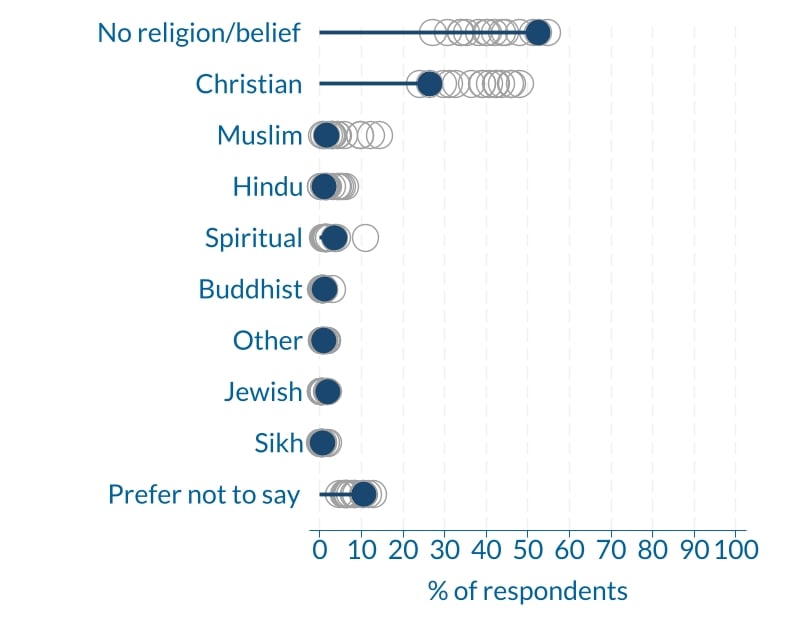
-
Question asked:
"What is your Sex?"
Accompanying note in portal:
This is the sex you were assigned at birth and we asked you to provide this information when you registered with the HCPC. For births registered in the UK, this will either be male or female. However, some other countries may include 'intersex' as an option. We also ask if your gender identity is different from the sex you were assigned at birth. Your gender identity may be the same as your assigned sex, but it may be different. You may identify as the opposite gender to your assigned sex, you may identify with neither, or with a self-described gender identity.Practitioner Psychologists
All professions
Sex Count % Count % Not recorded 0 0% 130 0% Recorded 27,085 100% 324,555 100% Female 21,495 79% 234,155 72% Male 4,600 17% 85,120 26% Intersex 0 0% 25 0% Prefer not to say 990 4% 5,255 2% 27,085 100% 324,555 100% 
-
Question asked:
"Which of the following best describes your sexual orientation?"
Portal category options:
- Heterosexual/straight
- Bisexual
- Gay woman/lesbian
- Gay man
- Pansexual
- Queer
- Asexual
- Prefer to self-describe
- Prefer not to sayPractitioner Psychologists
All professions
Sexual Orientation Count % Count % Not recorded 0 0% 15 0% Recorded 26,935 100% 214,500 100% Heterosexual 22,290 83% 186,780 87% Bisexual 640 2% 4,175 2% Lesbian 390 1% 3,130 1% Gay man 415 2% 2,855 1% Pansexual 135 1% 705 0% Queer 135 1% 580 0% Asexual 20 0% 215 0% Prefer to self-describe 50 0% 210 0% Prefer not to say 2,860 11% 15,850 7% 26,935 100% 214,500 100% 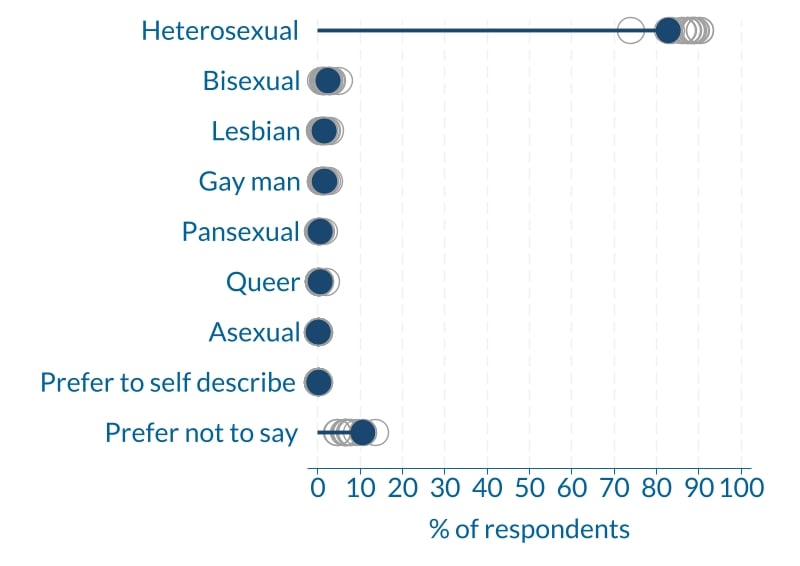
Help and guidance
Protected characteristics: The nine protected charateristics of the Equality Act 2010: Age, disability, ethnicity, gender reassignment, marriage and civil partnership, pregnancy and maternity, religion or belief, sex, sexual orientation.
Registrants: An active registrant on the HCPC register at the time of the analysis.
Respondents: Registrants who provided other protected characteristic EDI data via the portal or survey.
Count: Number of registrants (age & sex) or respondents (other protected characteristics).
Not recorded: Total number of registrants/respondents for whom this information is not held. For respondents these are due to data collection system errors and only includes those who have attempted to give this information.
Recorded: Total number of registrants/respondents for whom this information is held.
All professions
Age & Sex: All active registrants on the HCPC register, regardless of profession.
Other protected characterictics: All respondents of EDI regardless of profession.
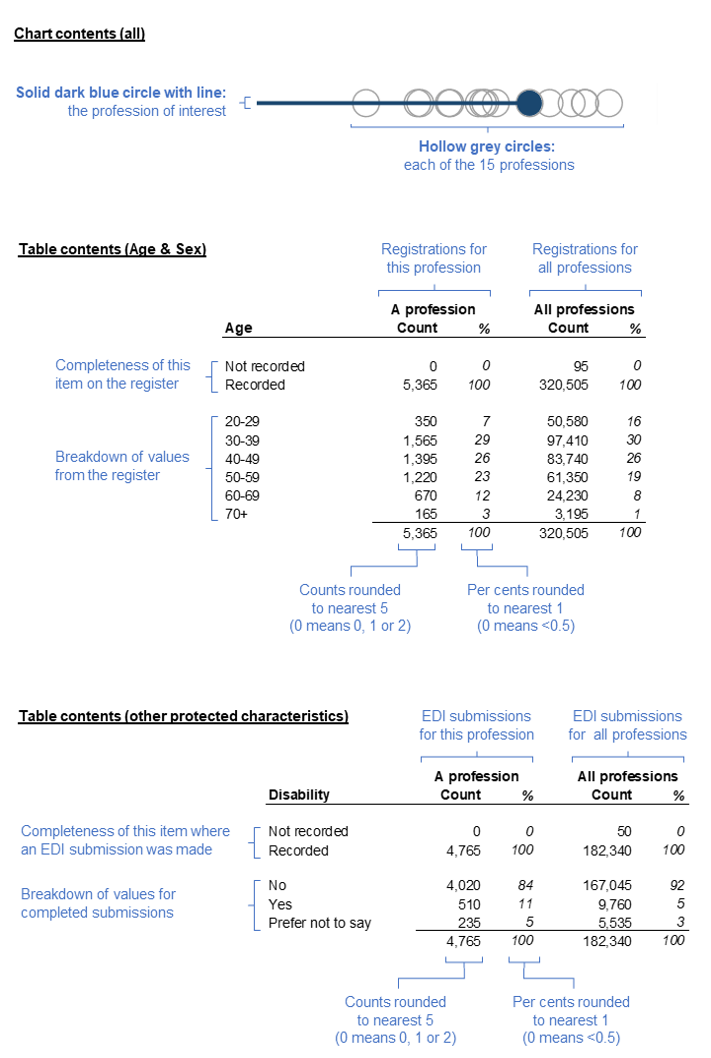
Supply of EDI data is voluntary and therefore is not complete for all registrants. As such the tables do not represent the entire register. Consideration of the coverage as detailed in the Demography section is important when using or generalising the findings.
Most registrants complete or update their EDI data at renewal, so it may be up to two years old.
All questions have a "prefer not to say" option which are included in the tables as it is a valid response and hence indicates that the question has been asked.
A small number of records were been affected by now resolved issues with the data collection systems that allowed no reponse to be recorded for certain questions. These are shown as 'Not recorded' in the tables.
Rounding has been used to control the risk of disclosure of personal information. Counts have been rounded to the nearest five. Therefore a count of 0 in a table represents either 0, 1 or 2 registrants with that characteristic.
- Published:
- 04/07/2023
- Resources
- Data
- Subcategory:
- Registrant data, Diversity data
- Profession
- Practitioner psychologists
